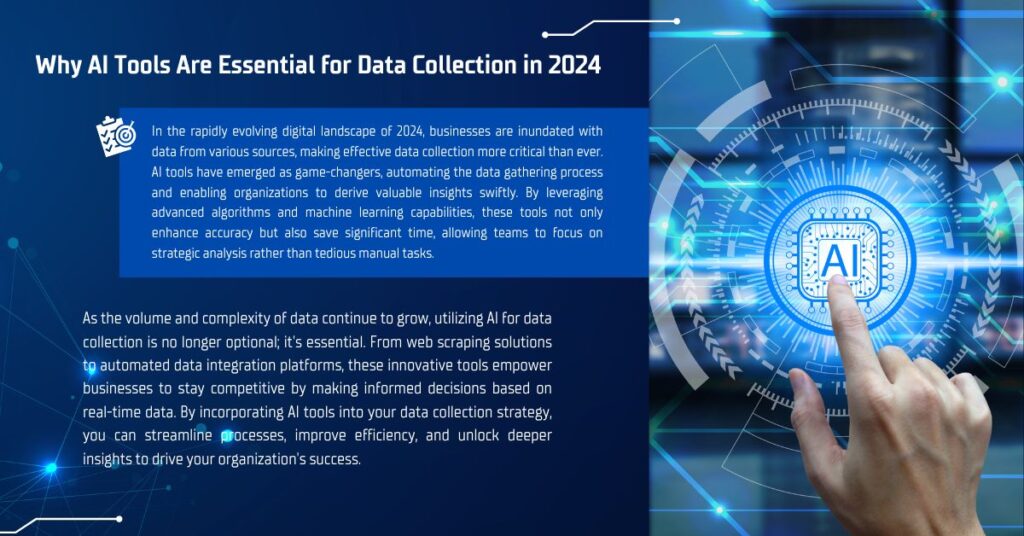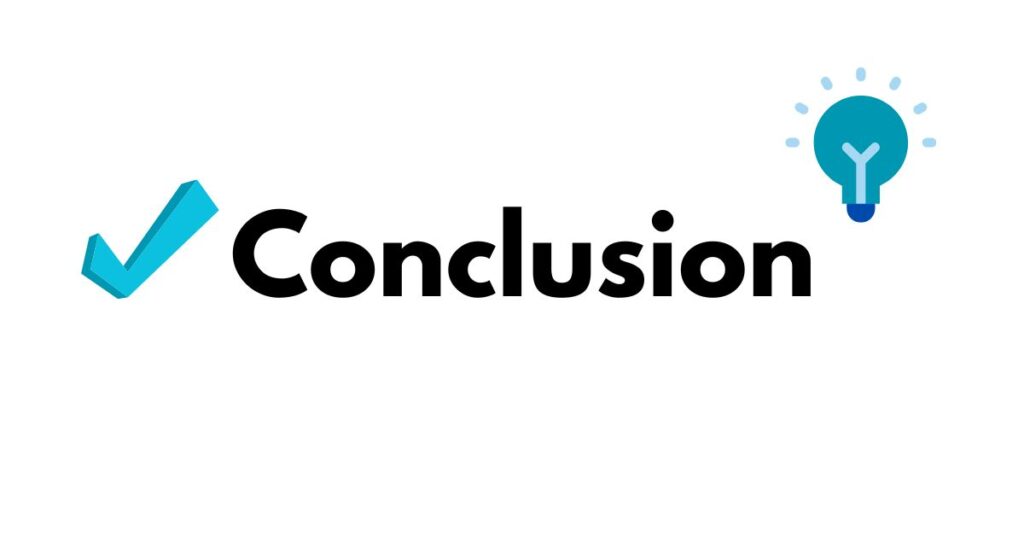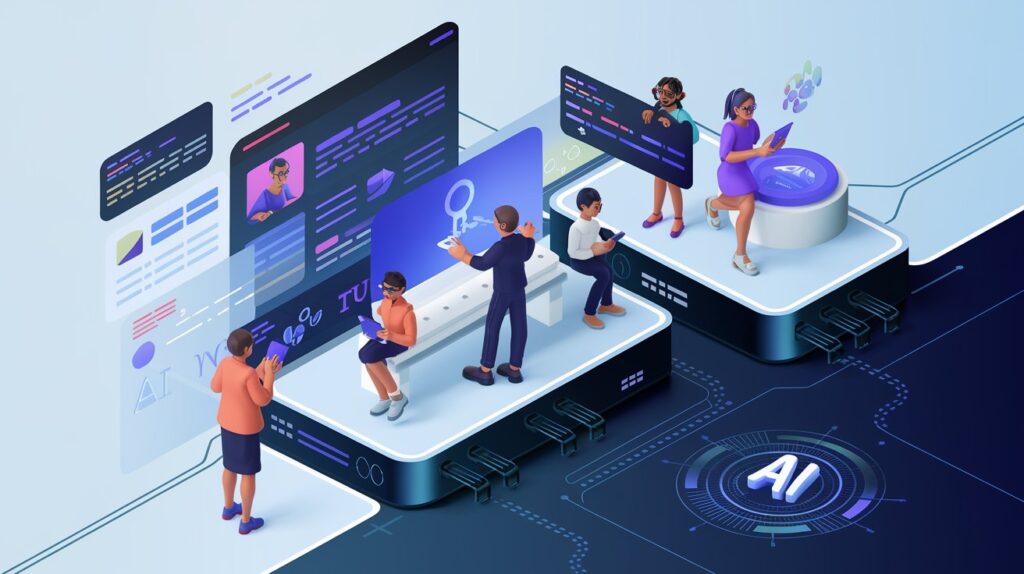Introduction
In today’s data-driven world, the ability to efficiently collect and analyze data is essential for business growth, research, and decision-making. A staggering 90% of the world’s data has been generated in the last two years alone, creating a need for tools that can manage and collect data effectively. Enter AI-powered data collection tools—these innovative solutions automate and streamline the process, allowing businesses to gather, clean, and organize massive datasets with unprecedented speed and accuracy.
In this article, we’ll explore the top AI tools for data collection in 2024, each designed to simplify data gathering, improve accuracy, and increase efficiency. By the end, you’ll have a clear understanding of the best tools available, how to choose the right one for your needs, and actionable tips to optimize your data collection process.
Table of Contents
Why AI-Powered Data Collection Matters
Before diving into specific tools, it’s important to understand the significance of AI in data collection. Traditional methods of collecting data are labor-intensive, prone to human error, and often inefficient when handling large volumes of data. AI enhances this process by:
- Automating repetitive tasks: AI can scan, extract, and organize data in seconds, saving hours of manual labor.
- Improving accuracy: Machine learning algorithms learn from mistakes and reduce the chances of human error.
- Scaling data operations: AI tools can handle massive datasets effortlessly, making them ideal for businesses or researchers working with big data.
Top AI Tools for Data Collection in 2024
Here’s a comprehensive list of the top AI tools you can leverage for data collection in 2024. We’ll break down their key features, pricing, and why they stand out.
1. MonkeyLearn
Overview: A user-friendly AI platform that specializes in text analysis, MonkeyLearn allows businesses to collect and analyze data from text-based sources such as emails, customer reviews, or social media. It integrates seamlessly with popular tools like Google Sheets, Excel, and Zapier.
- Features: Text classification, sentiment analysis, keyword extraction.
- Pros: Easy to use, customizable models, integrates with many platforms.
- Cons: Limited functionality for large datasets.
- Pricing: Free for basic usage, paid plans start at $299/month.
2. Scrapy
Overview: Scrapy is an open-source web crawling framework that allows users to collect data from websites using custom crawlers. It’s highly customizable and suitable for developers who want more control over their data collection process.
- Features: Web scraping, customizable spiders, integration with databases.
- Pros: Free, powerful for developers, versatile.
- Cons: Steep learning curve for non-developers.
- Pricing: Free.
3. Diffbot
Overview: Diffbot is an AI-powered web scraping tool that automatically organizes web data into structured information. It uses computer vision to analyze content, making it highly accurate for collecting data from a variety of sources.
- Features: Automatic API generation, entity extraction, image recognition.
- Pros: High accuracy, handles complex data, visual content analysis.
- Cons: High cost for large-scale operations.
- Pricing: Starts at $299/month.
4. Octoparse
Overview: Octoparse is a no-code web scraping tool designed for non-programmers. It allows users to set up data extraction from websites with ease, thanks to its visual workflow builder. Ideal for users who need to extract large amounts of structured data without coding.
- Features: No-code web scraping, cloud-based extraction, schedule scraping tasks.
- Pros: User-friendly, no coding required, handles large datasets.
- Cons: Limited to website data.
- Pricing: Free for basic use, paid plans start at $75/month.
5. Bright Data
Overview: Formerly known as Luminati, Bright Data is one of the most powerful web scraping platforms for large-scale operations. It provides proxies for anonymous data collection and ensures access to almost any web data.
- Features: Advanced proxy networks, data collection automation, high scalability.
- Pros: Large-scale data collection, reliable, extensive proxy options.
- Cons: Expensive, may require technical knowledge.
- Pricing: Plans start at $500/month.
6. ParseHub
Overview: ParseHub is another no-code data extraction tool that allows users to scrape websites and export data into multiple formats, including Excel and JSON. It supports dynamic content, making it perfect for collecting data from complex web pages.
- Features: No-code, dynamic content scraping, data export options.
- Pros: Easy to use, supports various formats, handles complex websites.
- Cons: Limited free tier, slower processing on large datasets.
- Pricing: Free for basic usage, paid plans start at $149/month.
7. Zyte (formerly Scrapinghub)
Overview: Zyte is a cloud-based web scraping tool that helps businesses extract valuable insights from websites. It offers managed data services, providing structured data from various sources.
- Features: Managed web scraping services, proxy management, data pipeline.
- Pros: Reliable, handles large-scale operations, provides structured data.
- Cons: High cost for custom projects.
- Pricing: Custom pricing based on needs.
8. Aito
Overview: Aito is an AI tool that specializes in predictive analytics and database querying. While not a traditional data collection tool, it helps companies analyze and predict patterns in their collected data.
- Features: Predictive queries, machine learning integration, data insights.
- Pros: Predictive capabilities, machine learning insights, easy integration.
- Cons: Limited to companies needing predictive analytics.
- Pricing: Custom pricing based on business size.
9. Algolia
Overview: Algolia is a powerful search and discovery API for delivering fast and relevant results to users. While it’s mainly used as a search engine, Algolia’s AI-driven engine can help businesses collect and analyze user behavior data, especially from e-commerce platforms.
- Features: AI-driven search engine, analytics, API integration.
- Pros: Fast, highly customizable, suitable for large-scale e-commerce platforms.
- Cons: Expensive for small businesses.
- Pricing: Free tier, paid plans start at $50/month.
10. Hevo Data
Overview: Hevo is a no-code data pipeline tool that helps businesses collect and integrate data from multiple sources into a central warehouse. Its AI-driven interface automates data pipeline management, making data collection seamless and efficient.
- Features: No-code data pipelines, real-time data sync, integration with popular tools.
- Pros: Easy to use, real-time syncing, scalable.
- Cons: Pricing may be steep for smaller teams.
- Pricing: Starts at $249/month.
Comparison Table: Top AI Data Collection Tools
| Tool | Features | Best For | Pricing | Pros | Cons |
|---|---|---|---|---|---|
| MonkeyLearn | Text classification, sentiment analysis | Text-based data collection | $299/month | Easy to use, customizable | Limited for large datasets |
| Scrapy | Web scraping framework | Developers | Free | Free, powerful for devs | Steep learning curve |
| Diffbot | Automatic web scraping | Structured web data | $299/month | Accurate, visual content analysis | Expensive |
| Octoparse | No-code web scraping | Non-programmers | $75/month | Easy setup, cloud-based | Website data only |
| Bright Data | Proxy networks | Large-scale operations | $500/month | High scalability, reliable | Expensive |
| ParseHub | Dynamic content scraping | Structured web data | $149/month | Easy, multi-format export | Slow on large datasets |
| Zyte | Managed scraping services | Large-scale web scraping | Custom pricing | Reliable, data pipelines | High cost |
| Aito | Predictive queries | Predictive analytics | Custom pricing | AI-driven insights | Limited to analytics |
| Algolia | AI-driven search engine | E-commerce, user behavior | $50/month | Fast, customizable | Expensive for small teams |
| Hevo Data | No-code data pipelines | Data integration | $249/month | Real-time sync, scalable | Pricey for small teams |
Why AI Tools Are Essential for Data Collection in 2024

FAQs
- What is AI-powered data collection?
AI-powered data collection refers to the use of artificial intelligence to automate the process of gathering, organizing, and analyzing data from various sources, such as websites, documents, and user interactions. AI tools can handle large volumes of data with increased speed and accuracy, reducing the need for manual intervention. - What are the benefits of AI in data collection?
The benefits of using AI for data collection include:- Automation: AI can perform tasks like web scraping, data extraction, and organization automatically, saving time and effort.
- Reduced human error: AI systems are less prone to mistakes compared to manual data entry or collection.
- Scalability: AI tools can handle large datasets effortlessly, making them ideal for businesses that deal with vast amounts of information.
- Faster data processing: AI can collect and process data at a much quicker rate than traditional methods, ensuring up-to-date and accurate insights.
- Improved insights: With machine learning, AI tools can identify patterns, trends, and anomalies that might be missed in manual data analysis.
- Is web scraping legal?
Web scraping is generally legal, but it depends on the terms of service of the website being scraped and local regulations. Some websites explicitly prohibit scraping, while others may allow it under specific conditions. It’s essential to review a site’s terms of service and use scraping tools responsibly to avoid legal issues. - How do I choose the right AI tool for data collection?
When selecting an AI tool for data collection, consider the following factors:- Data sources: Identify where your data comes from (websites, internal systems, etc.) and choose a tool that supports those sources.
- Budget: Ensure the tool fits your financial constraints. Some tools offer free plans, but larger-scale operations may require more expensive solutions.
- Ease of use: Determine whether you need a no-code tool or if your team has the technical skills for more complex solutions.
- Integration: Check if the tool integrates with your existing systems, such as CRMs, data warehouses, or analytics platforms.
- Scalability: Ensure the tool can grow with your business and handle increasing amounts of data over time.
- Can AI data collection tools handle real-time data?
Yes, many AI-powered data collection tools, like Hevo Data and Bright Data, offer real-time data collection and syncing capabilities. This ensures that the information you collect is always up to date, which is crucial for applications such as financial analysis or customer behavior tracking. - What are the common challenges in AI data collection?
- Data privacy: Collecting data from users or websites can raise privacy concerns, especially with sensitive information.
- Legal restrictions: Some regions have stringent data collection laws (e.g., GDPR in the EU), and non-compliance can result in penalties.
- Accuracy: While AI can reduce human error, it’s still essential to ensure the data being collected is relevant and accurate.
- Cost: High-end tools may come with steep pricing, especially for large-scale data operations.
- What types of data can AI collect?
AI can collect various types of data, including:- Text data: From websites, social media, emails, and documents.
- Structured data: From databases or spreadsheets.
- Unstructured data: Such as images, videos, or customer feedback.
- Behavioral data: Tracking user interactions, clicks, or movements on websites or apps.
- Financial data: Transaction records, market data, and stock prices.
- Can non-technical users use AI data collection tools?
Yes! Many AI tools, like Octoparse and ParseHub, are designed for non-technical users with drag-and-drop interfaces and no-code workflows. These tools allow users to set up data collection processes without requiring programming skills. - Are there free AI data collection tools?
Yes, several AI data collection tools offer free tiers or limited versions for small-scale operations. For example, Scrapy is an open-source tool that’s free, and Octoparse offers a free plan with basic features. However, more advanced features typically require paid subscriptions. - How can I ensure the data collected is of high quality?
To ensure data quality:
- Clean and preprocess data: Remove duplicates, inconsistencies, and irrelevant information.
- Validate sources: Use credible and reliable sources to collect data.
- Monitor collection processes: Regularly check for errors, broken links, or issues in your data pipeline.
- Use AI tools with built-in quality checks: Some tools automatically flag errors or clean data, improving overall quality.
Practical Tips for Streamlining Your Data Collection Process
To maximize efficiency and get the most out of AI-powered tools for data collection, follow these best practices:
- Set clear objectives: Before collecting any data, define your goals and what you intend to achieve. This will help you choose the right AI tool and guide your data collection efforts.
- Automate workflows: Many tools allow you to automate the entire data collection process. Set up scheduled tasks to gather data at regular intervals without manual intervention.
- Ensure compliance: Always adhere to legal guidelines like GDPR or CCPA to avoid compliance issues, especially when collecting user data.
- Leverage integrations: Choose tools that integrate with your existing software stack, whether that’s CRM platforms, analytics tools, or databases. This makes the transition from data collection to analysis smoother.
- Monitor for updates: Web structures can change, causing scraping tools to break. Keep an eye on your data pipelines and adjust configurations as necessary.
Conclusion

AI-powered data collection tools have revolutionized the way businesses, researchers, and professionals gather and analyze data. Whether you’re dealing with large-scale web scraping or specific text-based data extraction, the tools we’ve discussed—MonkeyLearn, Scrapy, Diffbot, Octoparse, and others—offer powerful solutions to streamline your processes in 2024.
By leveraging these AI tools, you can automate repetitive tasks, enhance accuracy, and focus on making data-driven decisions that propel your business forward. Whether you’re a small business owner or a data scientist, there’s an AI tool out there that fits your needs.
Take action today by trying out one of these AI-powered data collection tools and unlock the potential of efficient, scalable, and accurate data gathering in 2024. Let us know your experience in the comments, and don’t hesitate to explore our other articles on data management and AI innovations.


